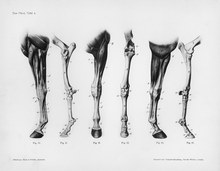Dr. Erin McKerney, in collaboration with Dr. Susan Stover from the J.D Wheat Veterinary Orthopedic Research Laboratory, at UC Davis is conducting a study to better understand the events that lead to catastrophic fractures of the humerus and scapula in racehorses.

Saving horses with fractured limbs
Researchers at the Veterinary Orthopedic Research Laboratory, at UC Davis are conducting a study to better understand the events that lead to catastrophic fractures of the humerus and scapula in racehorses.
© 2012 by Hermann Dittrich
These injuries can happen suddenly, unexpectedly and often without warning to horses under the care of a large variety of trainers. Complete fractures of the scapula and humerus are almost always fatal; but, when recognized early, the predisposing incomplete stress fractures can heal and horses are able to successfully return to racing.
The purpose of the study is to determine if there are any warning signs, no matter how subtle, that could be indicative of humeral or scapular stress fractures and impending catastrophic fracture. Better knowledge of any signs leading up to fracture, subtle or otherwise, will help trainers and veterinarians work together to identify mild injuries and prevent fatal injuries.
The study will be conducted by phone survey of trainers. The information will be kept strictly confidential, and will be summarized in anonymous form for use by trainers and veterinarians to aid injury prevention.
This study is done in concert with California’s Racing Safety Program. Racing Injury Prevention, an integrated part of the California’s Horse Racing Board’s Racing Safety Program dedicated to the welfare of equine athletes, jockeys and industry participants, which commenced in July of 2010 with a clear mission to reduce the incidence of debilitating and fatal injuries in horses at California racetracks and training facilities.
RSP is also designed to enhance the welfare of jockeys and exercise riders.
The Program has three parts: Equine Postmortem Program (Necropsy), Track Safety, and Racing Injury Prevention. Each part encompass’ highly trained teams of talented and compassionate people working tirelessly to make a difference in the lives of owners, trainers, jockeys, horsemen and equine athletes.
Together they are working to make evidence based recommendations to improve veterinary and training practices; educate owners, trainers, veterinarians and handlers; develop safety standards for track surfaces and surface maintenance to keep horses and jockeys safe from injury; and develop continuing education courses that reach beyond the scope of injury into awareness, prevention and rehabilitation.
